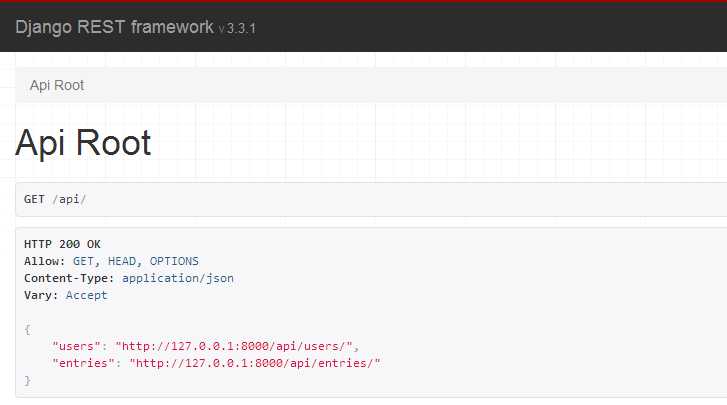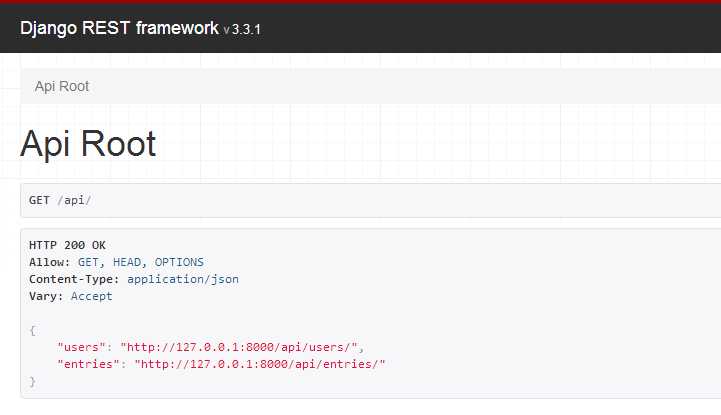1 参考博客:
http://blog.csdn.net/SVALBARDKSY/article/details/50548073

2 准备工作
1. 环境
Python: Python 3.5 Django: 1.9 django-filter: 0.11.0 djangorestframework: 3.3.1
2.准备工作
安装库 pip install django pip install djangorestframework pip install django-filter 创建工程 app django-admin startproject django_rest_framework_test cd django_rest_framework_test/ python manage.py startapp blog
3.定义Model
from django.db import models class User(models.Model): name = models.CharField(max_length=32) mail = models.EmailField()
.admin注册
from django.contrib import admin from blog.models import User # Register your models here. admin.register(User)
4. 构建DB
# 添加程序 blog INSTALLED_APPS = [ ‘django.contrib.admin‘, ‘django.contrib.auth‘, ‘django.contrib.contenttypes‘, ‘django.contrib.sessions‘, ‘django.contrib.messages‘, ‘django.contrib.staticfiles‘, ‘blog‘, ]
5.然后同步数据结构,默认使用Sqlite3.
python manage.py makemigrations
python manage.py migrate
6.admi后台
# 创建管理用户 python manage.py createsuperuser Username (leave blank to use ‘kimihiro_n‘): dev Email address: Password: Password (again): Superuser created successfully. # 启动服务器 python manage.py runserver

3 使用Djagno REST Framework
1.添加APP REST Framework
#django_rest_framework_test/settings.py INSTALLED_APPS = ( ... ‘blog‘, ‘rest_framework‘, )
2.生成REST
生成REST API最少需要定义下面3个。
- - Serializer
- - ViewSet
- - URL pattern
简单来说,Serializer是将「Model序列化」,ViewSet是API的应答器,URL Pattern定义了URL的路由。
2.1定义Serialzier
需要继承serializers.ModelSerializer, fields为API想要得到的字段。
#blog/serializer.py # coding: utf-8 from rest_framework import serializers from .models import User, Entry class UserSerializer(serializers.ModelSerializer): class Meta: model = User fields = (‘name‘, ‘mail‘)
2.2定义ViewSet
queryset设置为Model的queryset,serializer_class设置为刚才定义的serializer。
#blog/views.py # coding: utf-8 import django_filters from rest_framework import viewsets, filters from .models import User, Entry from .serializer import UserSerializer, EntrySerializer class UserViewSet(viewsets.ModelViewSet): queryset = User.objects.all() serializer_class = UserSerializer
2.3定义URL pattern
#django_rest_framework_test/urls.py # coding: utf-8 from django.conf.urls import url, include from django.contrib import admin from blog.urls import router as blog_router urlpatterns = [ url(r‘^admin/‘, admin.site.urls), #include blog.urls url(r‘^api/‘, include(blog_router.urls)), ]
#blog/urls.py # coding: utf-8 from rest_framework import routers from .views import UserViewSet, EntryViewSet router = routers.DefaultRouter() router.register(r‘users‘, UserViewSet) router.register(r‘entries‘, EntryViewSet)
4测试API
python manage.py runserver

5. 未完成
自定义API 真正运用的时候,可能需要对抽选进行过滤。另外比如 将关系表数据同时获取 例如下面的数据 { "title": "Hello, Django REST API!!", "body": "<script>alert(\"hello\");</script>", "created_at": "2015-12-09T05:59:46.200277Z", "status": "draft", "author": 1 } 1 2 3 4 5 6 7 返回的是author的ID。如果这样下次还要通过 /api/users/1再次请求User的数据。这样效率并不好,现在我们想获得下面的数据。 { "title": "Hello, Django REST API!!", "body": "<script>alert(\"hello\");</script>", "created_at": "2015-12-09T05:59:46.200277Z", "status": "draft", "author": { "name": "Alice", "mail": "alice@example.com" } } 1 2 3 4 5 6 7 8 9 10 在Serializer里把author的部分,再次定义一下。 blog/serializer.py … class EntrySerializer(serializers.ModelSerializer): # author的serializer author = UserSerializer() class Meta: model = Entry fields = (‘title‘, ‘body‘, ‘created_at‘, ‘status‘, ‘author‘) 1 2 3 4 5 6 7 8 9 EntrySerializer 重新定义author,这样获取的时候会同时获得User信息。 其他的自定义方法请参照 http://www.django-rest-framework.org/api-guide/serializers/ 分页 现在获取数据都是全件获取,数据量非常大的时候,需要对数量进行限制。 django_rest_framework_test/settings.py REST_FRAMEWORK = { ‘DEFAULT_PAGINATION_CLASS‘: ‘rest_framework.pagination.LimitOffsetPagination‘, ‘PAGE_SIZE‘: 2 } 1 2 3 4 5 设置需要全局设置。在配置文件里,定义REST_FRAMEWORK,设置DEFAULT_PAGINATION_CLASS和PAGE_SIZE。 这样API会出现offset(开始位置)和limit(限制件数, default=PAGE_SIZE)等参数。 { "count": 4, "next": "http://localhost:8000/api/entries/?limit=2&offset=2", "previous": null, "results": [ { "id": 1, "title": "Hello, Django REST Framework!!", "body": "Hello!", "created_at": "2015-12-12T11:55:22.310203Z", "status": "draft", "author": 1 }, { "id": 2, "title": "The Zen of Python", "body": "The Zen of Python, by Tim Peters\r\n\r\nBeautiful is better than ugly.\r\nExplicit is better than implicit.\r\nSimple is better than complex.\r\nComplex is better than complicated.\r\nFlat is better than nested.\r\nSparse is better than dense.\r\nReadability counts.\r\nSpecial cases aren‘t special enough to break the rules.\r\nAlthough practicality beats purity.\r\nErrors should never pass silently.\r\nUnless explicitly silenced.\r\nIn the face of ambiguity, refuse the temptation to guess.\r\nThere should be one-- and preferably only one --obvious way to do it.\r\nAlthough that way may not be obvious at first unless you‘re Dutch.\r\nNow is better than never.\r\nAlthough never is often better than *right* now.\r\nIf the implementation is hard to explain, it‘s a bad idea.\r\nIf the implementation is easy to explain, it may be a good idea.\r\nNamespaces are one honking great idea -- let‘s do more of those!", "created_at": "2015-12-12T11:56:32.854278Z", "status": "draft", "author": 2 } ] } 1 2 3 4 5 6 7 8 9 10 11 12 13 14 15 16 17 18 19 20 21 22 23 next,previous都会带有URL,非常的方便。 其他方式,参照 http://www.django-rest-framework.org/api-guide/pagination/ 筛选 如果想通过author来筛选Entry时。 django_rest_framework_test/settings.py REST_FRAMEWORK = { ‘DEFAULT_FILTER_BACKENDS‘: (‘rest_framework.filters.DjangoFilterBackend‘,) } 1 2 3 4 在配置文件里添加DEFAULT_FILTER_BACKENDS。和分页所设置的是同一个字典。 class EntryViewSet(viewsets.ModelViewSet): queryset = Entry.objects.all() serializer_class = EntrySerializer filter_fields = (‘author‘, ‘status‘) 1 2 3 4 然后在ViewSet里设置filter_fields。这样就可以通过author和status来筛选。 API后面为?author=1,就会抽选User id=1的blog。?status=public会抽选已经公开的Blog 其他筛选方法参照 http://www.django-rest-framework.org/api-guide/filtering/ 参考URL http://qiita.com/kimihiro_n/items/86e0a9e619720e57ecd8 http://www.django-rest-framework.org/ http://www.slideshare.net/unsolublesugar/res-tful http://qiita.com/KojiOhki/items/5be98eeae72dca2260bc http://racchai.hatenablog.com/entry/2016/04/12/Django_REST_framework_%E8%B6%85%E5%85%A5%E9%96%80
